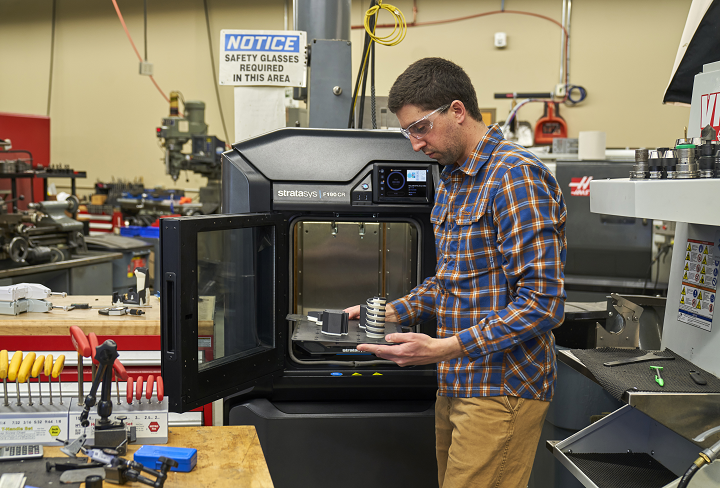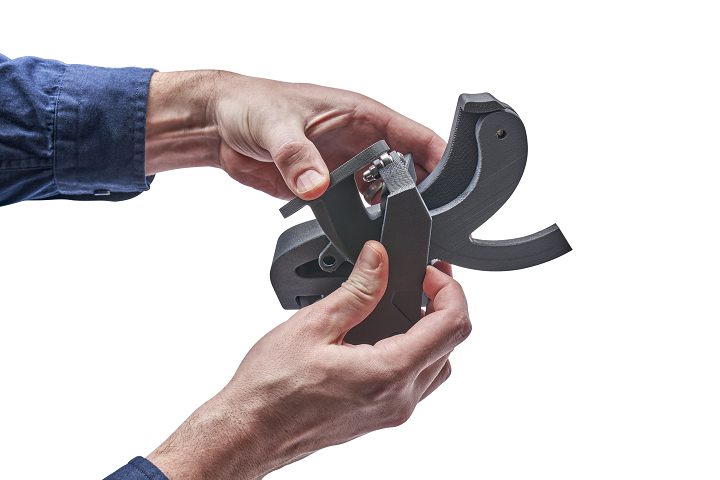In the last two months, Stratasys Ltd. (NASDAQ: SSYS) has qualified its Antero 840CN03 filament for 3D printed aerospace applications, published its first Sustainability Report, announced the latest two members of its GrabCAD Software Partner Program, and released the J850 TechStyle PolyJet printer for fashion 3D printing applications. But the polymer AM leader still isn’t slowing down, and just ahead of RAPID + TCT 2022 in Detroit next week, Stratasys dropped a trio of announcements introducing new materials, software, and 3D printers during its virtual Experience Stratasys: Manufacturing event.
The company offered a live, virtual press conference the day before the event, and Stratasys CEO Dr. Yoav Zeif told attendees that Stratasys is working to advance polymer additive manufacturing and “taking this industry from prototyping to manufacturing.”
“We are offering our customers a solution to what they need,” he said. “We are not selling what we have, we are addressing what they need.”
As such, the company has developed 16 new materials across three of its AM technologies—FDM, SAF, and P3—which will majorly increase the types of use cases with which Stratasys can work. Additionally, these include the first validated, third-party materials for the company’s FDM systems.
“When customers identify opportunities for how polymer 3D printing can transform their manufacturing, we want them to have the confidence that Stratasys has the solutions – that’s what leaders do. With five 3D printing technologies that address the vast majority of the industrial polymer market and an open software ecosystem across the entire digital thread, our growing material ecosystem means customers are getting more materials faster, allowing them to quickly turn their additive manufacturing ideas into reality,” Dr. Zeif said in a press release.
 Stratasys has introduced 16 new manufacturing materials across three different 3D printing technologies, including third-party materials for FDM 3D printers for the first time.
Stratasys has introduced 16 new manufacturing materials across three different 3D printing technologies, including third-party materials for FDM 3D printers for the first time.Last fall, Stratasys introduced an annual Open Material License (OML), which was, as Adam Pawloski, Vice President of Manufacturing Solutions for Stratasys, explained during the press event, a “significant and fundamental change to our materials model.” In this three-tiered structure around its materials, Stratasys Preferred Materials are at the top, and Validated Materials, developed with various suppliers and basic reliability testing, are in the middle, while Open Materials, which are not validated, are at the bottom. Now, Stratasys is partnering with Covestro, Kimya, and Victrex plc to enable the availability of its Validated Materials for FDM systems, beginning with the Fortus 450mc.
First, Stratasys has the new flame-resistant Covestro PA6/66 GF20 FR, a specialty, reinforced glass fiber composite, and then the standard-grade HIPS high-impact polystyrene. Kimya PC FR is a flame-resistant polycarbonate for engineering applications, and the high-performance options are two semi-crystalline polymers: Arkema/Kimya PEKK-SC is based on Arkema’s KEPSTAN, and VICTREX AM 200 is an LMPAEK thermoplastic that works with soluble supports. Additionally, the strong FDM Nylon-CF10 carbon fiber composite is a new addition to the Preferred Materials tier.
When Stratasys launched its OML last year, Origin One customers got access to novel materials for the printer’s Programmable PhotoPolymerization (P3) technology. Now, the company has added eight new exploratory materials to the OML program that will welcome more demanding end-use applications. The advanced open materials, which include photopolymer resins for applications in casting, ceramics, high-temperature, elastic, electrostatics dissipative (ESD), and molding, can be purchased directly from material partners and their distributors.
The new materials for the P3-based Origin One were contributed by multiple material developers, including:
- Arkema
- Covestro
- Evonik
- BASF Forward AM
- Tethon 3D
- Liqcreate
- polySpectra
- Mechnano
Finally, Stratasys announced that its H350 printer, powered by Selective Absorption Fusion (SAF) technology for volume-grade 3D printing, now supports polypropylene (PP) and PA12 powder. Versatile PP features high chemical resistance and ductility, flexibility, and the ability to be sterilized, while PA12 offers chemical resistance, geometric accuracy, and high stiffness. These two materials will open up applications in consumer goods, prosthetics, machine components, prototyping, and more.
During the press event, Professor Neil Hopkinson, the inventor of SAF technology and VP of Technology at Stratasys, gave a few examples of what customers have been printing with SAF technology, including one that made “a half a ton of parts” on two printers in three months. This was, he said, “a fine example” of scaling up into production.
Hopkinson also mentioned a customer that placed an order for 250 parts, which is “a relatively low number” for SAF technology; however, the parts were so large that only two at a time could fit into the print bed. The customer used two SAF machines to complete 125 builds within just a few weeks, which was pretty impressive in and of itself, but they also fit random, smaller parts from other jobs on the bed around the two large parts, showcasing flexibility.
Stratasys customers can use GrabCAD Print software to access system print parameters, which will allow for part performance optimization by refining the capabilities of all these new materials.
 The GrabCAD Additive Manufacturing Platform enables two-way connectivity between 3D printers, additive manufacturing and enterprise applications, and broader Industry 4.0 infrastructure.
The GrabCAD Additive Manufacturing Platform enables two-way connectivity between 3D printers, additive manufacturing and enterprise applications, and broader Industry 4.0 infrastructure.Speaking of GrabCAD, Stratasys announced that GrabCAD Print is available for its Origin One and Origin One Dental 3D printers. This is the first step in integrating Origin One into the company’s full platform, and will give users a streamlined 3D software solution for build file preparation and post-print analysis.
GrabCAD Print is an application of the open GrabCAD Additive Manufacturing Platform, which allows for two-way connectivity between AM and enterprise applications, 3D printers, and Industry 4.0 infrastructure; a GrabCAD Software Development Kit (SDK) is used to bring together third-party GrabCAD Software Partners and GrabCAD applications. All of this is to say that manufacturers can now manage production-scale 3D printing on the Origin One and Origin One Dental from beginning to end, and users can enjoy a more consistent experience and connectivity with Stratasys.
“We are very focused on automating the workflow to make it an easier, balanced workflow for our customers,” Ronen Lebi, Head of Production Business Unit at Stratasys, explained during the event.
Stratasys says this new software enables better print preparation and automatic support generation, access to the aforementioned OML so users can develop and manage materials with optimized settings and profiles, and new functionality, including a scheduler, labeling, print status monitoring, and native CAD file support. GrabCAD Print for the Stratasys Origin One is free for existing Origin One and Origin One Dental customers.
 GrabCAD Print will provide users with an integrated, all-in-one software solution for streamlining the 3D printing workflow for print build file preparation and post print analysis.
GrabCAD Print will provide users with an integrated, all-in-one software solution for streamlining the 3D printing workflow for print build file preparation and post print analysis.In addition to GrabCAD Print, there are two other new offerings for the Origin One printers, including an on-premise printer configuration called Origin One Local that has the printer’s same functionalities. This will allow customers in sectors with extreme IT restrictions, like defense and government, to use the Origin One. Additionally, the new ProAero air extractor system is available for integration with the Origin One, as well as office-based PolyJet 3D printers. While the system, which extracts air from printers in order to capture and filter out dust, fumes, and odor, is a professional one, Stratasys calls it a plug-and-play. These three new Origin One offerings should be available later this year.
Finally, the company has expanded its F123 series with the introduction of the new composite-ready F190CR and the F370CR 3D printers, designed as a high-strength supplemental technology for industrial machinists and manufacturers.
“Stratasys is providing manufacturers with the 3D printers and materials to support the growth of additive manufacturing on the factory floor, including these new printers that give manufacturers the ability to build stronger, print stiffer and print more accurately. We have the verified and published data that proves these new printers have dimensional repeatability of up to 99% regardless of part size or geometric complexity. That, together with 99% uptime and unique service and support, gives manufacturers the confidence to accelerate their adoption of additive manufacturing,” stated Dick Anderson, Senior Vice President, Manufacturing for Stratasys.
 New Stratasys composite-ready 3D printers are designed for manufacturers to supplement traditional fabrication technologies with high-strength composite 3D printing.
New Stratasys composite-ready 3D printers are designed for manufacturers to supplement traditional fabrication technologies with high-strength composite 3D printing.These new 3D printers are meant for fabricating end-use parts, like jigs, fixtures, and work-holding tools, faster and more cost-effectively out of high-strength and high-stiffness materials. The composite-ready F190CR and F370CR printers have a larger build volume and oven size, soluble support options, and more material availability, and taller parts can be 3D printed thanks to a larger, heated build chamber and the ability to use stabilizer walls. Additional features include:
- integrated GrabCAD Print software
- reusable build trays
- built-in camera for remote monitoring
- 7″ control touchscreen
- enterprise application connectivity through the MTConnect standard and GrabCAD SDK
In addition, the new F370CR includes automatic material change, so printing is not interrupted if a canister is empty; a new one replaces it, and the print goes on uninterrupted.
Dave Thompson, VP of Worldwide Engineering and Customer Care – Contractor Equipment Division for fluid handling equipment leader Graco, Inc., has worked in engineering for more than 35 years, and has enjoyed innovating with Stratasys systems for over 20 of those. Graco is an F370CR beta customer, and, as Thompson said in a press release, the printer will enable the company to “bring our AM applications to a new level, extend the life of our tools and even provide for a better surface finish.”
 New printers and Nylon carbon fiber material expand applications for additive manufacturing on the factory floor.
New printers and Nylon carbon fiber material expand applications for additive manufacturing on the factory floor.These new 3D printers can help customers like Graco increase their AM applications in the factory, and so can FDM Nylon-CF10, another new material Stratasys is introducing. Meant for use with the F123 Series, this chopped carbon fiber composite is nearly three times as stiff, and over 60% stronger, than its nylon base, and when paired with soluble support, users should be able to easily print complex geometries.
The new FDM Nylon-CF10 material, and composite-ready F190CR and F370CR printers, are available to order, and should ship in June.
(Source/Images: Stratasys)
Subscribe to Our Email Newsletter
Stay up-to-date on all the latest news from the 3D printing industry and receive information and offers from third party vendors.
You May Also Like
Gorilla Sports GE’s First 3D Printed Titanium Cast
How do you help a gorilla with a broken arm? Sounds like the start of a bad joke a zookeeper might tell, but it’s an actual dilemma recently faced by...
Nylon 3D Printed Parts Made More Functional with Coatings & Colors
Parts 3D printed from polyamide (PA, Nylon) 12 using powder bed fusion (PBF) are a mainstay in the additive manufacturing (AM) industry. While post-finishing processes have improved the porosity of...
$25M to Back Sintavia’s Largest Expansion of Metal 3D Printing Capacity Since 2019
Sintavia, the digital manufacturing company specializing in mission-critical parts for strategic sectors, announced a $25 million investment to increase its production capacity, the largest expansion to its operations since 2019....
Velo3D Initiates Public Offering in a Bid to Strengthen Financial Foundations and Drive Future Growth
Velo3D (NYSE: VLD) has been among a number of publicly traded 3D printing firms that have attempted to weather the current macroeconomic climate. After posting a challenging financial report for 2023,...






























